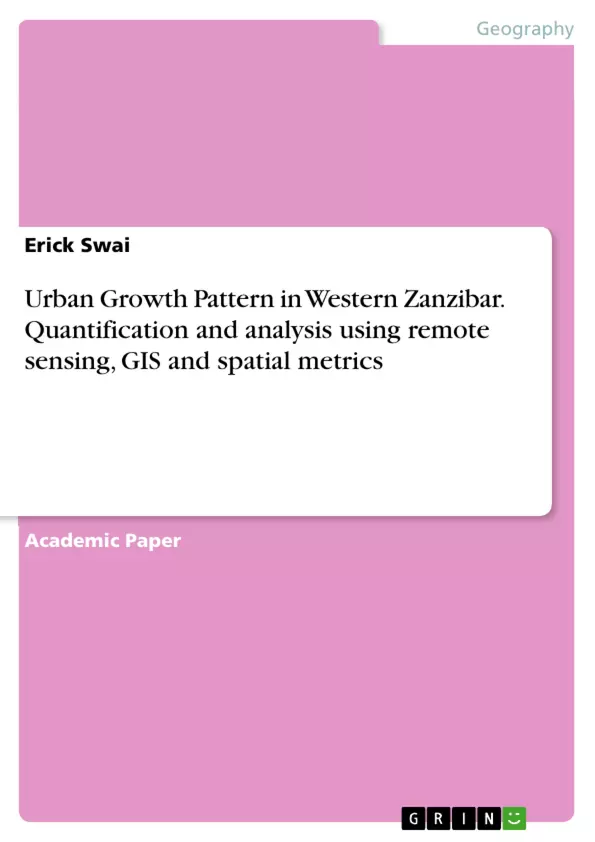This research aimed at analysing and quantifying urban growth pattern of Urban-West in Zanzibar using Remote Sensing, GIS and Spatial Metrics. To achieve this goal various data were used such as Landsat images, Sentinel 2A image and Building data have been utilized.
Urbanization is a phenomenon that is of major concern in both developing and developed countries. According to the census record between 1988 and 2002 there was a near-doubling of the urbanized population in Urban-West of region Zanzibar Island and continued high growth since 2002 are unprecedented in intensity, scope and impacts on the lands, particular in Urban-West. Such rapid urbanization of West district has meant that the city has doubled in areal extent. Currently there is lack of timely and quantitative information of the urban growth and its long-term impacts, thus planners haven’t been able to assess and analyse consistently growth of Urban-West in Zanzibar.
Keywords: GIS, Land cover, Remote sensing, spatial, Urban growth
Inhaltsverzeichnis (Table of Contents)
- INTRODUCTION
- 1.1 Background
- 1.2 Description of the study area
- 1.3 Statement of research problem
- 1.4 Objectives
- 1.4.1 Main objective
- 1.4.2 Specific objectives
- 1.5 Research question
- 1.6 Significance of the research
- 1.7 Beneficiaries
- 1.8 Tools, equipment and facilities
- LITERATURE REVIEW
- 2.1 Introduction
- 2.2 Remote Sensing and Urban Growth
- 2.3 Spatial Metrics
- 2.3.1 Densification
- 2.4 Image Classification
- 2.4.1 Supervised Classification
- 2.4.1.1 Support Vector Machine (SVM)
- 2.4.2 Unsupervised Classification
- 2.4.1 Supervised Classification
- 2.5 Change Detection
- 2.5.1 Post Classification Comparison
- 2.6 Resampling
- 2.6.1 Nearest Neighbour
- CHAPTER THREE
- 3.1 Introduction
- 3.2 Data Acquisition
- 3.3 Image pre-processing
- 3.3.1 Layer Stacking
- 3.3.2 Image re-projection
- 3.3.3 Resampling
- 3.3.4 Image Sub-setting
- 3.3.5 Training Samples
- 3.4 Image Processing
- 3.4.1 Image Classification
- 3.4.2 Accuracy Assessment
- 3.4.3 Change Detection
- 3.5 Densification
- 3.5.1 Area stratification
- 3.5.2 Building Density Extraction
- CHAPTER FOUR
- 4.1 Introduction
- 4.2 Results of classification
- 4.3 Result of accuracy assessment
- 4.4 Statistics of land cover changes between 1995 and 2009
- 4.5 Land covers change
- 4.6 Urban Sprawl
- 4.7 Result of densification
- 4.7.1 Building density in 2005
- 4.7.2 Building density in 2017
- CONCLUSION AND RECOMMENDATION
- 5.1 Conclusion
- 5.2 Recommendation
Zielsetzung und Themenschwerpunkte (Objectives and Key Themes)
This research focuses on analyzing and quantifying the urban growth patterns of Urban-West in Zanzibar using remote sensing, GIS, and spatial metrics. It aims to provide planners with quantitative information on urban expansion and its impacts, enabling them to make informed decisions for better urban planning and development.
- Urban growth patterns in Urban-West, Zanzibar.
- Application of remote sensing and GIS for urban growth analysis.
- Utilization of spatial metrics, particularly building density, to quantify urban expansion.
- Assessment of land cover change and its implications for urban development.
- Recommendations for urban planning and management based on the research findings.
Zusammenfassung der Kapitel (Chapter Summaries)
The introductory chapter sets the stage by discussing the context of rapid urbanization in sub-Saharan Africa and the importance of quantifying urban growth patterns. The study area, Urban-West in Zanzibar, is described, highlighting its historical development and the significance of understanding its recent urban expansion. The research objectives, questions, and significance are outlined, emphasizing the need for improved urban planning based on accurate data.
The literature review examines existing research on remote sensing, GIS, and spatial metrics in the context of urban growth analysis. It delves into various methods, including image classification, change detection, and densification, highlighting the use of Support Vector Machine (SVM) for supervised classification and the importance of spatial metrics in characterizing urban sprawl.
Chapter three outlines the methodology employed in the research, including data acquisition, image pre-processing, and image processing. This chapter details the steps involved in land cover mapping using Landsat and Sentinel 2A imagery, along with the application of SVM for classification and change detection analysis.
Chapter four presents the results of the research, focusing on the classification results, accuracy assessment, and analysis of land cover changes between 1995 and 2020. The findings include a significant increase in built-up areas and the identification of urban sprawl patterns. Additionally, the chapter presents the results of building density analysis, demonstrating how densification has varied across different parts of Urban-West.
Schlüsselwörter (Keywords)
This research focuses on the use of GIS, remote sensing, and spatial metrics for quantifying and analyzing urban growth patterns in Urban-West, Zanzibar. The key terms and concepts explored include land cover change, building density, urban sprawl, and the application of techniques such as image classification, change detection, and spatial metrics analysis. The study aims to contribute to the development of better urban planning and management strategies based on these key elements.
- Quote paper
- Erick Swai (Author), 2021, Urban Growth Pattern in Western Zanzibar. Quantification and analysis using remote sensing, GIS and spatial metrics, Munich, GRIN Verlag, https://www.grin.com/document/1139037



